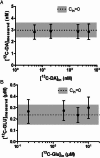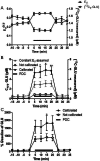In vivo calibration of microdialysis using infusion of stable-isotope labeled neurotransmitters
- PMID: 23374073
- PMCID: PMC3656751
- DOI: 10.1021/cn300199m
In vivo calibration of microdialysis using infusion of stable-isotope labeled neurotransmitters
Abstract
In vivo calibration of microdialysis probes is required for interpreting measured concentrations. The most popular method of in vivo calibration is no-net-flux (NNF), which requires infusing several concentrations of neurotransmitters to determine in vivo recoveries (extraction fraction or Ed) and extracellular concentrations. A new method for in vivo calibration of microdialysis of neurotransmitters using glutamate (GLU) and dopamine (DA) as model analytes is reported. (13)C6-DA and (13)C5-GLU were perfused through microdialysis probes as internal calibrators. Using liquid chromatography with mass spectrometry, it was possible to distinguish the (13)C-forms from the endogenous forms of each neurotransmitter. Ed was directly calculated by measuring the loss of the (13)C-forms during infusion. The measured endogenous (12)C forms of the neurotransmitters could be corrected for Ed to give calibrated extracellular concentrations in vivo. Retrodialysis of stable-isotope-labeled (SIL) neurotransmitters gave Ed and extracellular concentrations of (13)C5-GLU and (13)C6-DA that matched no-net-flux measurements; however, the values were obtained in a fraction of time because no added measurements were required to obtain the calibration. Ed was reduced during uptake inhibition for GLU and DA when measured by SIL retrodialysis. Because Ed is directly measured at each microdialysis fraction, it was possible to monitor changes in Ed under transient conditions created by systemic injection of uptake inhibitors. The results show that DA and GLU concentrations are underestimated by as much as 50% if not corrected for Ed during uptake inhibition. SIL retrodialysis provides equivalent information to NNF at much reduced time and animal use.
Figures






Similar articles
-
In vivo microdialysis and gas-chromatography/mass-spectrometry for 13C-enrichment measurement of extracellular glutamate in rat brain.J Neurosci Methods. 2002 Oct 30;120(2):179-92. doi: 10.1016/s0165-0270(02)00201-7. J Neurosci Methods. 2002. PMID: 12385768
-
Microdialysis of dopamine interpreted with quantitative model incorporating probe implantation trauma.J Neurochem. 2003 Aug;86(4):932-46. doi: 10.1046/j.1471-4159.2003.01904.x. J Neurochem. 2003. PMID: 12887691 Free PMC article.
-
Glial uptake of neurotransmitter glutamate from the extracellular fluid studied in vivo by microdialysis and (13)C NMR.J Neurochem. 2002 Nov;83(3):682-95. doi: 10.1046/j.1471-4159.2002.01161.x. J Neurochem. 2002. PMID: 12390530
-
13C enrichment of extracellular neurotransmitter glutamate in rat brain--combined mass spectrometry and NMR studies of neurotransmitter turnover and uptake into glia in vivo.Cell Mol Biol (Noisy-le-grand). 2003 Jul;49(5):819-36. Cell Mol Biol (Noisy-le-grand). 2003. PMID: 14528919 Review.
-
Changes in dialysate concentrations of glutamate and GABA in the brain: an index of volume transmission mediated actions?J Neurochem. 2003 Apr;85(1):23-33. doi: 10.1046/j.1471-4159.2003.01692.x. J Neurochem. 2003. PMID: 12641724 Review.
Cited by
-
Cocaine and desipramine elicit distinct striatal noradrenergic and behavioral responses in selectively bred obesity-resistant and obesity-prone rats.Behav Brain Res. 2018 Jul 2;346:137-143. doi: 10.1016/j.bbr.2017.11.009. Epub 2017 Nov 9. Behav Brain Res. 2018. PMID: 29129597 Free PMC article.
-
Microdialysis Coupled with LC-MS/MS for In Vivo Neurochemical Monitoring.AAPS J. 2017 Sep;19(5):1284-1293. doi: 10.1208/s12248-017-0114-4. Epub 2017 Jun 28. AAPS J. 2017. PMID: 28660399 Free PMC article.
-
Analytical Techniques in Neuroscience: Recent Advances in Imaging, Separation, and Electrochemical Methods.Anal Chem. 2017 Jan 3;89(1):314-341. doi: 10.1021/acs.analchem.6b04278. Epub 2016 Nov 22. Anal Chem. 2017. PMID: 28105819 Free PMC article. No abstract available.
-
D-Serine Signaling and NMDAR-Mediated Synaptic Plasticity Are Regulated by System A-Type of Glutamine/D-Serine Dual Transporters.J Neurosci. 2020 Aug 19;40(34):6489-6502. doi: 10.1523/JNEUROSCI.0801-20.2020. Epub 2020 Jul 13. J Neurosci. 2020. PMID: 32661027 Free PMC article.
-
Parsing glucose entry into the brain: novel findings obtained with enzyme-based glucose biosensors.ACS Chem Neurosci. 2015 Jan 21;6(1):108-16. doi: 10.1021/cn5002304. Epub 2014 Dec 9. ACS Chem Neurosci. 2015. PMID: 25490002 Free PMC article. Review.
References
-
- Chefer V. I.; Zapata A.; Shippenberg T. S.; Bungay P. M. (2006) Quantitative no-net-flux microdialysis permits detection of increases and decreases in dopamine uptake in mouse nucleus accumbens. J. Neurosci. Methods 155, 187–193. - PubMed
-
- Bungay P. M.; Morrison P. F.; Dedrick R. L. (1990) Steady-state theory for quantitative microdialysis of solutes and water in vivo and in vitro. Life Sci. 46, 105–119. - PubMed
-
- Yim H. J.; Gonzales R. A. (2000) Ethanol-induced increases in dopamine extracellular concentration in rat nucleus accumbens are accounted for by increased release and not uptake inhibition. Alcohol 22, 107–115. - PubMed
Publication types
MeSH terms
Substances
Grants and funding
LinkOut - more resources
Full Text Sources
Other Literature Sources
Miscellaneous

